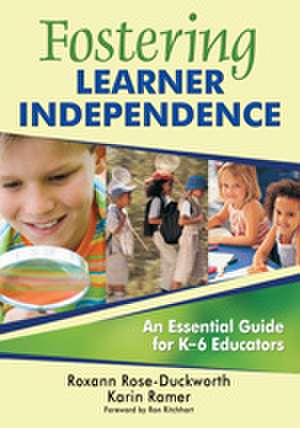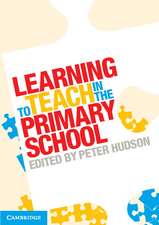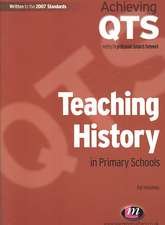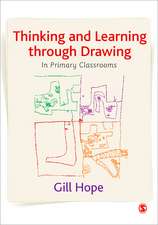Fostering Learner Independence: An Essential Guide for K-6 Educators
Autor Roxann Rose-Duckworth, Karin Rameren Limba Engleză Paperback – 9 dec 2008
Preț: 305.00 lei
Nou
Puncte Express: 458
Preț estimativ în valută:
58.36€ • 62.41$ • 48.66£
58.36€ • 62.41$ • 48.66£
Carte tipărită la comandă
Livrare economică 17 aprilie-01 mai
Preluare comenzi: 021 569.72.76
Specificații
ISBN-13: 9781412966078
ISBN-10: 1412966078
Pagini: 240
Dimensiuni: 178 x 254 x 15 mm
Greutate: 0.5 kg
Ediția:1
Editura: SAGE Publications
Colecția Corwin
Locul publicării:Thousand Oaks, United States
ISBN-10: 1412966078
Pagini: 240
Dimensiuni: 178 x 254 x 15 mm
Greutate: 0.5 kg
Ediția:1
Editura: SAGE Publications
Colecția Corwin
Locul publicării:Thousand Oaks, United States
Recenzii
“The authors have written a highly accessible book that could change not only the way teachers teach and students learn, but also contribute to the satisfaction that both teachers and students feel at the end of the day.”
"This book has challenged me as a teacher, and I believe others will become better teachers with this book."
“Teachers and administrators will find this book valuable. It has a strong theory and research base along with concrete examples from many classrooms.”
"The authors have spent years thinking and writing about the conditions necessary to design, implement, and reflect upon for teachers to be intentional in our work and what independence means for our students. Their book acts as a personal coach for any teaching wanting to increase the rigor of their classroom, establish a classroom of independence, manage their own planning time productively, increase parent support, and truly increase student achievement."
"This excellent book covers all aspects of what teachers can do with their students to help them develop as independent learners.”
“This one will be dog-eared, highlighted intensely, and readily accessible on the corner of my desk. However, in the spirit of this book’s call for independent thinking, don’t take my word for it. Read and judge for yourself. You won’t be disappointed.”
"This book has challenged me as a teacher, and I believe others will become better teachers with this book."
“Teachers and administrators will find this book valuable. It has a strong theory and research base along with concrete examples from many classrooms.”
"The authors have spent years thinking and writing about the conditions necessary to design, implement, and reflect upon for teachers to be intentional in our work and what independence means for our students. Their book acts as a personal coach for any teaching wanting to increase the rigor of their classroom, establish a classroom of independence, manage their own planning time productively, increase parent support, and truly increase student achievement."
"This excellent book covers all aspects of what teachers can do with their students to help them develop as independent learners.”
“This one will be dog-eared, highlighted intensely, and readily accessible on the corner of my desk. However, in the spirit of this book’s call for independent thinking, don’t take my word for it. Read and judge for yourself. You won’t be disappointed.”
Cuprins
Foreword by Ron Ritchhart
Preface
Acknowledgments
About the Authors
1. Learner Independence
Defining Learner Independence
Learner Independence Encourages Self-Esteem
Independent Learning: A Habit of Mind
Conclusion
A Time to Reflect
A Visit to Our Classrooms
2. Structuring for Learner Independence
Controlling Versus Structuring for Learning
Fostering Independence Through Student Thinking
Interdependence Encourages Independence
Conclusion
A Time to Reflect
A Visit to Our Classrooms
3. Teaching That Promotes Independence
Implicit and Explicit Teaching
Constructivist Education
Supporting Students: The Zone of Proximal Development
Problem-Based Instruction
Gradually Releasing Responsibility
Conclusion
A Time to Reflect
A Visit to Our Classrooms
4. Expectations and Communication That Supports Independence
Benefits of a Well-Managed Classroom
Setting Expectations
Communicating With Students
Language of the Classroom
Peer Communication
Conclusion
A Time to Reflect
A Visit to Our Classrooms
5. Aligning Understandings and the Environment for Independence
Benefits of a Well-Planned Environment
An Environment That Mirrors a Teacher's Understandings
Analyzing the Physical Environment
Role of the Teacher
Conclusion
A Time to Reflect
A Visit to Our Classrooms
6. Setting Up for Independence
Arranging the Physical Environment
Whole Group
Small Group
Student Seating
Student Seating: The Freedom to Choose
The Teacher's Desk
Learning Centers, Materials, Supplies, and Resources
Wall Space
A Final Touch
Routines and Procedures
Change Over Time
Conclusion
A Time to Reflect
A Visit to Our Classrooms
7. Assessment That Fosters Independence
A Comparison of Assessments
The Link Between Rubrics and Independence
Assessment That Encourages Independence and Creativity
Assessing With Purpose
Reflect on Your Use of Rubrics
The Benefits of Assessment for Learning
Conclusion
A Time to Reflect
A Visit to Our Classrooms
8. Evaluation and Analysis That Develops Independence
Supporting Students Through Evaluation
Using Evaluation in Planning
Conclusion
A Time to Reflect
A Visit to Our Classrooms
9. Information That Fosters Learner Independence
Observations as Assessment
Conversations as Assessment
Feedback: Descriptive and Evaluative
Feedback That Informs Instruction
Analyzing Student Work for Evidence of Instruction
Analyzing With Others
Conclusion
A Time to Reflect
A Visit to Our Classrooms
10. Planning to Support Independence
Purposeful Decisions
The Teaching and Learning Cycle
Long-Range Planning
Daily Planning
Approaches, Grouping, and Resources
Conclusion
A Time to Reflect
A Visit to Our Classrooms
11. Differentiating for Independence
All Students Can Learn
Teaching Responsively Encourages Independence
Using a Variety of Processes and Resources to Encourage Independence
Go Deep, Avoid Coverage
Students Need to Know Themselves as Learners
Student Choice Is Critical
Differentiation Leads to Independent Learners
Conclusion
A Time to Reflect
A Visit to Our Classrooms
12. Conclusion: Changing and Reflecting
Our Behaviors Are Influenced by Thought and Perception
Teaching Is Constant Decision Making
Learning Requires Engagement and Alteration in Thought
Humans Continue to Grow Cognitively
Resource A: Task Analysis
Resource B: Moving From Controlling Learning
Resource C: Responses That Encourage Independence
References
Index
Preface
Acknowledgments
About the Authors
1. Learner Independence
Defining Learner Independence
Learner Independence Encourages Self-Esteem
Independent Learning: A Habit of Mind
Conclusion
A Time to Reflect
A Visit to Our Classrooms
2. Structuring for Learner Independence
Controlling Versus Structuring for Learning
Fostering Independence Through Student Thinking
Interdependence Encourages Independence
Conclusion
A Time to Reflect
A Visit to Our Classrooms
3. Teaching That Promotes Independence
Implicit and Explicit Teaching
Constructivist Education
Supporting Students: The Zone of Proximal Development
Problem-Based Instruction
Gradually Releasing Responsibility
Conclusion
A Time to Reflect
A Visit to Our Classrooms
4. Expectations and Communication That Supports Independence
Benefits of a Well-Managed Classroom
Setting Expectations
Communicating With Students
Language of the Classroom
Peer Communication
Conclusion
A Time to Reflect
A Visit to Our Classrooms
5. Aligning Understandings and the Environment for Independence
Benefits of a Well-Planned Environment
An Environment That Mirrors a Teacher's Understandings
Analyzing the Physical Environment
Role of the Teacher
Conclusion
A Time to Reflect
A Visit to Our Classrooms
6. Setting Up for Independence
Arranging the Physical Environment
Whole Group
Small Group
Student Seating
Student Seating: The Freedom to Choose
The Teacher's Desk
Learning Centers, Materials, Supplies, and Resources
Wall Space
A Final Touch
Routines and Procedures
Change Over Time
Conclusion
A Time to Reflect
A Visit to Our Classrooms
7. Assessment That Fosters Independence
A Comparison of Assessments
The Link Between Rubrics and Independence
Assessment That Encourages Independence and Creativity
Assessing With Purpose
Reflect on Your Use of Rubrics
The Benefits of Assessment for Learning
Conclusion
A Time to Reflect
A Visit to Our Classrooms
8. Evaluation and Analysis That Develops Independence
Supporting Students Through Evaluation
Using Evaluation in Planning
Conclusion
A Time to Reflect
A Visit to Our Classrooms
9. Information That Fosters Learner Independence
Observations as Assessment
Conversations as Assessment
Feedback: Descriptive and Evaluative
Feedback That Informs Instruction
Analyzing Student Work for Evidence of Instruction
Analyzing With Others
Conclusion
A Time to Reflect
A Visit to Our Classrooms
10. Planning to Support Independence
Purposeful Decisions
The Teaching and Learning Cycle
Long-Range Planning
Daily Planning
Approaches, Grouping, and Resources
Conclusion
A Time to Reflect
A Visit to Our Classrooms
11. Differentiating for Independence
All Students Can Learn
Teaching Responsively Encourages Independence
Using a Variety of Processes and Resources to Encourage Independence
Go Deep, Avoid Coverage
Students Need to Know Themselves as Learners
Student Choice Is Critical
Differentiation Leads to Independent Learners
Conclusion
A Time to Reflect
A Visit to Our Classrooms
12. Conclusion: Changing and Reflecting
Our Behaviors Are Influenced by Thought and Perception
Teaching Is Constant Decision Making
Learning Requires Engagement and Alteration in Thought
Humans Continue to Grow Cognitively
Resource A: Task Analysis
Resource B: Moving From Controlling Learning
Resource C: Responses That Encourage Independence
References
Index
Notă biografică
Roxann Rose-Duckworth is an innovative elementary and middle school teacher, college instructor to preservice educators, and respected educational consultant. Rose-Duckworth has nearly fifteen years experience working with students in kindergarten through sixth grade in three different states. She was recognized for her creative and effective teaching strategies in 1996 when the Walt Disney Company honored her dedication to her students as one of 36 teachers chosen nationwide to be honored by Disney¿s American Teacher Awards. Rose-Duckworth¿s teaching was highlighted in The Creative Classroom Project, a video series by Harvard Graduate School of Education¿s Project Zero (1999-2004). She has presented at national conferences for both ASCD and IRA and published articles in NCTE¿s Primary Voices. In 2006, Rose-Duckworth co-authored The Teaching Experience: An Introduction to Reflective Practice (Pearson). She enjoys preparing future teachers for tomorrow¿s classrooms and working with current teachers to help them reflect on and improve their teaching practices. Rose-Duckworth takes an active role in North Sound Reading Council, her local International Reading Association affiliated organization.
Descriere
Understand how to create learner independence and therefore student success








